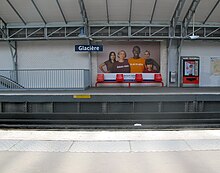Glacière (Métro Paris)
|
|
|
|---|---|

|
|
| Tariff zone | 1 |
| Line (s) |
|
| place | Paris XIII |
| opening | April 24, 1906 |
The metro station Glacière is a high station of line 6 of the Paris Métro .
location
The station is located on the border of the Quartier de Croulebarbe and the Quartier de la Maison-Blanche in the 13th arrondissement of Paris . It lies above the median of the Boulevard Auguste-Blanqui west of its intersection with the Rue de la Glacière.
Surname
It is named after the Rue de la Glacière, which was already marked on maps as Chemin de la Glacière in the 17th century. This route led from Paris to the village of La Glacière, where the ice from the numerous ponds, which were frozen in winter, was stored in brick shafts and abandoned tunnels for the summer.
history
On April 24, 1906, the station went into operation with the opening of the extension of line 2 Sud from Passy to Place d'Italie . Line 2 Sud was abandoned as such on October 14, 1907, and its route to the southwest end section of line 5 ( Étoile - Gare du Nord ).
In order to be able to better distribute the flow of visitors in the course of the Paris colonial exhibition of 1931, line 6 ran for the first time on the Etoile - Place d'Italie section, as it has a conveniently located transfer station to line 8 at the Daumesnil station . After the end of the exhibition, the old lines were restored. It was not until October 6, 1942 that they were changed again to the effect that line 6 has been running at the Glacière station since then. In July 1974 this line was converted for traffic with pneumatic trains .
description
The structure of the station corresponds to most of the other high-altitude stations on Line 6. It is 75 m long and has 4.10 m wide side platforms on the two parallel tracks. Two longitudinal beams, each resting on a row of iron columns, carry the track bed and the inner edges of the platforms. Their outer edges and the side walls rest on two further longitudinal girders, which are supported by brick pillars. At the four corners of the station, a pillar protrudes over the roof for design reasons. The station has a gable roof - glass near the ridge - which also spans the tracks. The brick side walls show geometric ornaments on the outside.
Access is through a brick-built access building via a staircase that divides halfway up at the western end of the station.
vehicles
Initially, trains with wooden superstructures ran on the route, consisting of two approximately 8 m long, two-axle railcars and six similar trailer cars . From around 1907, four-car, later five-car trains of the Sprague-Thomson design, resting on bogies , ran . In July 1974, line 6 was converted to rubber-tired vehicles, and since then there have been trains from the MP 73 series consisting of three multiple units and two sidecars .
Remarks
- ↑ "Glacière" refers to an artificially created cellar for the preservation of ice
- ↑ Since line 2 was originally planned as a circular railway, but was not designed as such, its line number initially existed twice as lines 2 north (today's line 2 ) and 2 south
- ↑ Line 5 temporarily ended at the Place d'Italie station when coming from the north
- ↑ The eastern end point Porte de Charenton of line 8 was at the main entrance of the colonial exhibition
- ↑ At the similarly constructed elevated railway stations on Line 2, the side walls are glazed and only the platforms, but not the tracks, are covered
- ↑ A railcar with a one-sided driver's cab runs at each end of the train, with a driverless cab and two non-motorized sidecars in between
Web links
literature
- Gérard Roland: Stations de métro. D'Abbesses à Wagram . 2003, ISBN 2-86253-307-6 .
Individual evidence
- ^ Gérard Roland: Stations de métro d'Abbesses à Wagram . Christine Bonneton, Clermont-Ferrand 2011, ISBN 978-2-86253-382-7 , pp. 113 .
- ^ Jean Tricoire: Un siècle de métro en 14 lignes. De Bienvenüe à Météor . 2nd Edition. La Vie du Rail, Paris 2000, ISBN 2-902808-87-9 , p. 210 .
- ↑ Jean Tricoire: op.cit. P. 210 f.
- ^ Brian Hardy: Paris Metro Handbook . 3. Edition. Capital Transport Publishing, Harrow Weald 1999, ISBN 1-85414-212-7 , pp. 36 .
- ↑ Jean Tricoire: op.cit. P. 51.
- ↑ Jean Tricoire: op.cit. P. 53.
- ^ Gérard Roland: op.cit. P. 114 f.
- ↑ Jean Tricoire: op.cit. P. 84 f.
| Previous station | Paris metro | Next station |
|---|---|---|
|
Saint-Jacques ← Charles de Gaulle - Étoile |
|
Corvisart Nation → |
Coordinates: 48 ° 49 ′ 52.2 " N , 2 ° 20 ′ 36.2" E

